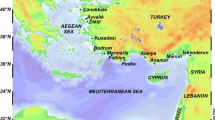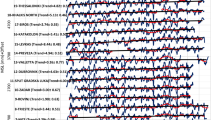Abstract
This study examined daytime and nighttime sea surface temperature (SST) and its diurnal variability (D-SST) in three regions of the northern Bay of Bengal (BoB) during 2000–2019 by using MODIS Terra satellite data. An increasing trend of SST was observed in the Bangladesh coast, outer coast, and offshore. The trend was ranged around 0.10–0.16 °C per decade during daytime and 0.18–0.27 °C per decade during nighttime. The increased SST in the study area may be attributed due to rapid industrialization and global warming. Monthly SST represented four successive phases, such as warming-cooling and warming-cooling, which started in February. Month wise SST concentrations varied from 29.74 °C to 23.32 °C during nighttime and 29.613 °C to 23.446 °C during daytime in the northern BoB. The comparative SST among three different stations showed that annual offshore SST was higher during daytime and lower during nighttime than the outer & Bangladesh coast. Annual daytime maximum and minimum SST were observed at 28.45 °C and 27.27 °C, respectively. During the nighttime, it was ranged from 28.33 °C to 27.05 °C. The presence of nearby landmass may be the factor behind the variation of SST during day and nighttime. About 65–80% of monthly D-SST and 70–80% of annual D-SST value was recorded below 0.3 °C in our study area. A significantly (p < 0.001) moderate correlation (r = 0.54) was found between the MODIS Terra satellite data and NODC in-situ data.








Similar content being viewed by others
Data Availability
The datasets generated during and/or analysed during the current study will be made available on reasonable request.
Code Availability
The codes used during the current study are available from the corresponding author on reasonable request.
References
Abhiya AM, Minu S, Ramachandrankizhur. (2015) Salient Long-term Observations of SST along Kerala Coast and its Comparative Variation with Lakshadweep Coast. Aquatic Procedia 4(October):556–562. https://doi.org/10.1016/j.aqpro.2015.02.072
Bellenger H, Duvel J-P (2009) An analysis of tropical ocean diurnal warm layers. J Clim 22(13):3629–3646
Bhat GS, Gadgil S, Hareesh Kumar PV, Kalsi SR, Madhusoodanan P, Murty VSN, Prasada Rao CVK, Babu VR, Rao LVG, Rao RR (2001) BOBMEX: The Bay of Bengal monsoon experiment. Bull Am Meteor Soc 82(10):2217–2244
Brunke MA, Zeng X, Misra V, Beljaars A (2008) Integration of a prognostic sea surface skin temperature scheme into weather and climate models. Geophys Res Atmosp 113(D21).
Casey KS, Cornillon P (1999) A comparison of satellite and in situ–based sea surface temperature climatologies. J Clim 12(6):1848–1863
Change IPOC (1990) Climate change: the IPCC scientific assessment. Mass, Cambridge
Dasgupta S, Laplante B, Meisner C, Wheeler D, Yan J (2007) The impact of sea level rise on develo** countries: a comparative analysis. The World Bank
Dinesh Kumar PK, Paul YS, Muraleedharan KR, Murty VSN, Preenu PN (2016) Comparison of long-term variability of Sea Surface Temperature in the Arabian Sea and Bay of Bengal. Regional Stud Marine Sci 3:67–75. https://doi.org/10.1016/j.rsma.2015.05.004
Donlon CJ, Minnett PJ, Gentemann C, Nightingale TJ, Barton IJ, Ward B, Murray MJ (2002) Toward improved validation of satellite sea surface skin temperature measurements for climate research. J Clim 15(4):353–369
Eastwood S, Le Borgne P, Péré S, Poulter D (2011) Diurnal variability in sea surface temperature in the Arctic. Remote Sens Environ 115(10):2594–2602
Gentemann CL, Minnett PJ, Le Borgne, P, Merchant CJ (2008) Multi‐satellite measurements of large diurnal warming events. Geophys Res Lett 35(22)
Gentemann CL, Minnett PJ, Sienkiewicz J, Demaria M, Cummings J, ** Y, Doyle JD, Gramer L, Barron CN, Casey KS (2009) MISST: the multi-sensor improved sea surface temperature project. Oceanography 22(2):76–87
Gong S, Wong K (2018) Spatio-temporal analysis of sea surface temperature in the East China Sea using TERRA/MODIS products data. Sea Level Rise Coast Infrastruct 213–227
Hepplewhite CL (1989) Remote observation of the sea surface and atmosphere The oceanic skin effect. Int J Remote Sens 10(4–5):801–810
Hsu J, Hendon H, Feng M, Zhou X (2019) Magnitude and phase of diurnal SST variations in the ACCESS-S1 model during the suppressed phase of the MJOs. J Geophys Res Oceans 124(12):9553–9571
Jaswal AK, Singh V, Bhambak SR (2012) Relationship between sea surface temperature and surface air temperature over Arabian Sea, Bay of Bengal and Indian Ocean. J Ind Geophys Union 16(2):41–53
Kamykowski D, Milligan EJ, Reed RE (1998) Relationships between geotaxis/phototaxis and diel vertical migration in autotrophic dinoflagellates. J Plankton Res 20(9):1781–1796
Kawai Y, Wada A (2007) Diurnal sea surface temperature variation and its impact on the atmosphere and ocean: A review. J Oceanogr 63(5):721–744
Khan TMA, Singh OP, Rahman MDS (2000) Recent sea level and sea surface temperature trends along the Bangladesh coast in relation to the frequency of intense cyclones. Mar Geodesy 23(2):103–116
Kilpatrick KA (2013) Climate Algorithm Theoretical Basis Document (C-ATBD): Pathfinder SST. CDRP-ATBD-0099 v2
Kilpatrick KA, Podesta GP, Evans R (2001) Overview of the NOAA/NASA advanced very high resolution radiometer Pathfinder algorithm for sea surface temperature and associated matchup database. J Geophys Res Oceans 106(C5):9179–9197
Kilpatrick KA, Podestá G, Walsh S, Williams E, Halliwell V, Szczodrak M, Brown OB, Minnett PJ, Evans R (2015) A decade of sea surface temperature from MODIS. Remote Sens Environ 165:27–41
Kucera M (2019) Determination of past sea surface temperatures. Elsevier Inc., In Encyclopedia of Ocean Sciences (Issue July). https://doi.org/10.1016/B978-0-12-409548-9.11384-3
Levitus S (1982) Climatological atlas of the world ocean (Vol. 13). US Department of Commerce, National Oceanic and Atmospheric Administration
Minnett PJ (2019) Satellite remote sensing of sea surface temperatures. Elsevier Inc., In Encyclopedia of Ocean Sciences (Issue June). https://doi.org/10.1016/B978-0-12-409548-9.04340-2
Mujumdar M, Salunke K, Rao SA, Ravichandran M, Goswami BN (2010) Diurnal cycle induced amplification of sea surface temperature intraseasonal oscillations over the Bay of Bengal in summer monsoon season. IEEE Geosci Remote Sens Lett 8(2):206–210
Notarstefano G, Mauri E, Poulain P-M (2006) Near-surface thermal structure and surface diurnal warming in the Adriatic Sea using satellite and drifter data. Remote Sens Environ 101(2):194–211
Prasanna Kumar S, Muraleedharan PM, Prasad TG, Gauns M, Ramaiah N, De Souza SN, Sardesai S, Madhupratap M (2002) Why is the Bay of Bengal less productive during summer monsoon compared to the Arabian Sea? Geophys Res Lett 29(24):81–88
Qin H, Chen G, Wang W, Wang D, Zeng L (2014) Validation and application of MODIS-derived SST in the South China Sea. Int J Remote Sens 35(11–12):4315–4328. https://doi.org/10.1080/01431161.2014.916439
Sarangi RK, Devi KN (2017) Space-based observation of chlorophyll, sea surface temperature, nitrate, and sea surface height anomaly over the Bay of Bengal and Arabian Sea. Adv Space Res 59(1):33–44. https://doi.org/10.1016/j.asr.2016.08.038
Sea Surface Temperature : Ocean Health Index. (n.d.)
Shenoi SSC, Nasnodkar N, Rajesh G, Joseph KJ, Suresh I, Almeida AM (2009) On the diurnal ranges of Sea Surface Temperature (SST) in the north Indian Ocean. J Earth Syst Sci 118(5):483
Shetye SR, Gouveia AD, Shankar D, Shenoi SSC, Vinayachandran PN, Sundar D, Michael GS, Nampoothiri G (1996) Hydrography and circulation in the western Bay of Bengal during the northeast monsoon. J Geophys Res Oceans 101(C6):14011–14025
Singh OP (2012) Satellite derived sea surface temperature variability in the Bay of Bengal. Mausam 63(1):71–76
Singh P, Chowdary JS, Gnanaseelan C (2013) Impact of prolonged La Niña events on the Indian Ocean with a special emphasis on southwest Tropical Indian Ocean SST. Global Planet Change 100:28–37
Sohou Z, Koné V, Da-Allada YC, Djakouré S, Bourlès B, Racape V, Degbe G, Adje C (2020) Seasonal and inter-annual ONSET Sea Surface Temperature variability along the northern coast of the Gulf of Guinea. Regional Stud Marine Sci 35:101129. https://doi.org/10.1016/j.rsma.2020.101129
Strong AE, Liu G, Meyer J, Hendee JC, Sasko D (2004) Coral reef watch 2002. Bull Mar Sci 75(2):259–268
Tanahashi S, Kawamura H, Takahashi T, Yusa H (2003) Diurnal variations of sea surface temperature over the wide‐ranging ocean using VISSR on board GMS. J Geophys Res Oceans 108(C7)
Townsend DW, Bennett SL, Thomas MA (2005) Diel vertical distributions of the red tide dinoflagellate Alexandrium fundyense in the Gulf of Maine. Deep Sea Res Part II 52(19–21):2593–2602
Tyagi G, Babu KN, Mathur AK, Solanki HA (2018) INSAT-3D and MODIS retrieved sea surface temperature validation and assessment over waters surrounding the Indian subcontinent. Int J Remote Sens 39(5):1575–1592
Van der Leeden P (2015) In situ validation of satellite sea surface temperature measurements in a northern california upwelling area (Issue 2 (22)). San Francisco State University
Vecchi GA, Harrison DE (2002) Monsoon breaks and subseasonal sea surface temperature variability in the Bay of Bengal. J Clim 15(12):1485–1493
Vinayachandran PN, Neema CP, Mathew S, Remya R (2012) Mechanisms of summer intraseasonal sea surface temperature oscillations in the Bay of Bengal. J Geophys Res Oceans 117(C1)
Walton CC, Pichel WG, Sapper JF, May DA (1998) The development and operational application of nonlinear algorithms for the measurement of sea surface temperatures with the NOAA polar-orbiting environmental satellites. J Geophys Res Oceans 103(C12):27999–28012. https://doi.org/10.1029/98JC02370
Wang S, Tang D (2010) Remote sensing of day/night sea surface temperature difference related to phytoplankton blooms. Int J Remote Sens 31(17–18):4569–4578
Wick GA, Bates JJ, Scott DJ (2002) Satellite and skin-layer effects on the accuracy of sea surface temperature measurements from the GOES satellites. J Atmos Oceanic Tech 19(11):1834–1848
Zhang H, Beggs H, Majewski L, Wang XH, Kiss A (2016) Investigating sea surface temperature diurnal variation over the Tropical Warm Pool using MTSAT-1R data. Remote Sens Environ 183:1–12
Acknowledgements
The authors are thankful to APDRC (Asia-Pacific Data-Research Center) and Ocean Color NASA for the MODIS-Terra satellite data. For in-situ data, the authors have acknowledged the World Ocean Database (WOD) of the National Oceanographic Data Center (NODC) of NOAA.
Funding
No funding was received to assist with the preparation of this manuscript.
Author information
Authors and Affiliations
Contributions
Conceptualization, Methodology, Investigation, writing original draft, Data curation, Validation:[Md. Shahin Hossain Shuva]; Conceptualization, Methodology, Investigation, Formal analysis, Writing original draft, Visualization, Validation: [Md Rony Golder]; Conceptualization, Reviewing and Editing: [Muhammad Abdur Rouf]; Reviewing and editing: [Mohammad Muslem Uddin]; Reviewing and Editing: [Joyanto Bir].
Corresponding author
Ethics declarations
Conflicts of interest
On behalf of all authors, the corresponding author states that there is no conflict of interest.
Additional information
Publisher's Note
Springer Nature remains neutral with regard to jurisdictional claims in published maps and institutional affiliations.
Rights and permissions
About this article
Cite this article
Shuva, M.S.H., Golder, M.R., Rouf, M.A. et al. Daytime and Nighttime Sea Surface Temperature (SST) along with Diurnal Variability (D-SST) in the Northern Bay of Bengal: A Remote Sensing Approach. Thalassas 38, 697–708 (2022). https://doi.org/10.1007/s41208-022-00406-8
Received:
Revised:
Accepted:
Published:
Issue Date:
DOI: https://doi.org/10.1007/s41208-022-00406-8




